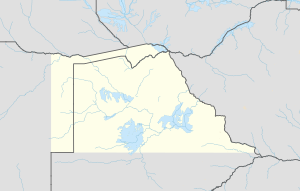Zambesia facts for kids
Quick facts for kids
Zambesia
|
|
|---|---|

Zambesia as proposed by the Movement for the Survival of the River Races of Zambesia
|
|
| Capital | Linyanti |
| Common languages | English |
| Demonym(s) | Zambesi, Zambesian |
Zambesia is a special region in southern Africa. It has a long and important history. People used to call it Sebitwane country, Makololo country, or Sekeletu country. Its history goes back even before British and German areas were set up in the late 1800s.
Later, when colonial powers divided the land, the people of Zambesia were split up among different countries. This made it hard for them to keep their culture together. They also had to work hard to be recognized and to have a say in their own future.
Contents
A Look at History
The Zambesia region has a very rich and varied past. Its story began with old cultures and societies that lived along the Zambezi, Kwando, Linyanti, and Chobe Rivers.
In the late 1800s, powerful European countries started to take control of parts of Africa. This time is known as the Scramble for Africa. This changed the Zambesia region a lot.
Challenges Today
Today, the people of Zambesia still face many challenges. These issues affect their daily lives, their culture, and their rights.
Being Recognized as Indigenous
The people of Zambesia are not officially recognized as indigenous (native) people in Namibia. The country's laws say that no one should be treated unfairly because of their background. However, there are no specific laws to protect the rights of indigenous groups. This lack of recognition can make it harder for them to have a voice in government. It also affects their economic, social, and cultural rights.
Facing Challenges and Finding Opportunities
Many Zambesians live in isolated areas, especially in the Caprivi Strip. There are not many roads or other important services. This makes it hard for them to find jobs. Most people farm along the rivers to feed their families. But there are not many other job chances or investments in the area. This means many people are still living in poverty.
Land Use and Environmental Concerns
There have been disagreements about how land is used in Zambesia. For example, a large foreign company was allowed to use community land for a tobacco farm. Some people were worried about this decision. They feared it would harm traditional ways of life and make it harder to grow food. They also worried about damage to the environment. The region has a lot of potential for farming and tourism that is not yet fully used.
Speaking Up for Their Rights
The people of Zambesia sometimes find it hard to express their opinions freely. There are rules about public gatherings and meetings, especially if they are about wanting more self-governance. This can make it difficult for them to share their ideas about having more control over their own future.
Important Legal Cases
Zambesia's history also includes some important legal cases. One of the biggest trials in Namibia's history was the Caprivi Treason Trial. Many people linked to the Caprivi Liberation Army were involved. After a long process, many of them were found not guilty. This trial helped bring attention to questions of fairness and justice for those involved.
Joining UNPO
The Unrepresented Nations and Peoples Organization (UNPO) is a group that helps speak up for communities around the world that are not fully represented. The Zambesia region is part of UNPO through the work of the Movement for the Survival of the River Races in Zambesia (MOSURIRAZA).
MOSURIRAZA is a peaceful group that works to empower Zambesian voices. They want to raise awareness about the challenges the region faces. Their goals fit well with UNPO's mission to help unrepresented nations and peoples share their concerns.
See also
- Makololo
- Indigenous Peoples in Namibia
- Caprivi Strip



